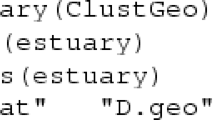Summary
For the detection and description of pattern in data from quadrats arranged in a grid or belt, an alternative is proposed to the usual hierarchical analysis of variance. Quadrats at specified spacings of interest are paired at random, and the variance between quadrats so paired is then related to the inter-quadrat distance Examples are given, and the advantages of this method compared with that hitherto employed are discussed.
Similar content being viewed by others
References
Anderson, D. J. 1961. The structure of some upland plant communities in Caernarvonshire. I. The pattern shown by Pteridium aquilinum. J. Ecol. 49: 369–376.
Anderson, D. J. 1967. Studies on structure in plant communities. III. Data on pattern in colonizing species. J. Ecol. 55: 397–404.
Anderson, D. J. 1971. Spatial patterns in some Australian dryland plant communities. In ‘Statistical Ecology Volume 1. Spatial Patterns and Statistical Distributions’ ed. G. P. Patil, E. C. Pielou and W. E. Waters, Pennsylvania St. Univ. Press. University Park. pp. 271–285.
Bartlett, M. S. 1964. The spectral analysis of two-dimensional point processes. Biometrika 51: 299–311.
Fisser, H. G. 1969. Plant pattern and distribution in ecosystems and relationships to function. In ‘The Grassland Ecosystem. A Preliminary Synthesis’, ed. R. L. Dix and R. F. Beidleman. Colo. St. Univ. Range Sci. Ser. 2, pp. 183–196.
Goodall, D. W. 1952. Quantitative aspects of plant distribution. Biol. Rev. 27: 194–245.
Goodall, D. W. 1954. Minimal area: a new approach. VIIIth Internat. Bot. Congr., Ecology: 19–21.
Goodall, D. W. 1961. Objective methods for the classification of vegetation IV. Pattern and minimal area. Aust. J. Bot. 9: 162–196.
Goodall, D. W. 1963. Pattern analysis and minimal area — some further comments. J. Ecol. 51: 705–710.
Goodall, D. W. 1970. Statistical plant ecology. Ann. Rev. Ecol. Syst. 1: 99–124.
Greig-Smith, P. 1952. The use of random and contiguous quadrats in the study of the structure of plant communities. Ann. Bot. Lond. NS. 16: 293–316.
Greig-Smith, P. 1961. Data on pattern within plant communities. I. The analysis of pattern. J. Ecol. 49: 695–702.
Greig-Smith, P. 1964. Quantitative plant ecology. 2nd ed. Butterworths, London. xii + 256 pp.
Greig-Smith, P. & M. J. Chadwick. 1965. Data on pattern within plant communities. III. Acacia-Capparis semi-desert scrub in the Sudan. J. Ecol. 53: 465–474.
Holgate, P. 1965. Some new tests of randomness. J. Ecol. 53: 261–266.
Kershaw, K. A. 1958. An investigation of the structure of a grassland community I. The pattern of Agrostis tenuis. J. Ecol. 46: 571–592.
Kershaw, K. A. 1962. Quantitative ecological studies from Landmannathellir, Iceland. III. Variation of performance in Carex bigelowii. J. Ecol. 50: 393–399.
Kershaw, K. A. 1964. Quantitative and dynamic ecology. Arnold, London. 183 pp.
Krishna Iyer, P. V. 1949. The first and second moments of some probability distributions arising from points on a lattice and their application. Biometrika 36: 135–141.
Morisita, M. 1959. Measuring the dispersion of individuals and analysis of the distributional pattern. Mem. Fac. Sci. Ryushu Univ., Ser. E (Biol). 2: 215–235.
Phillips, M. E. 1954. Studies in the quantitative morphology and ecology of Eriophorum angustifolium Roll. II. Competition and dispersion. J. Ecol. 42: 187–210.
Pielou, E. C. 1964. The spatial pattern of two-phase patchworks of vegetation. Biometrics 20: 156–167.
Pielou, E. C. 1969. An introduction to mathematical ecology. Wiley-Interscience, New York etc. X + 286 pp.
Thompson, H. R. 1955. Spatial point processes with application to ecology. Biometrika 42: 102–115.
Thompson, H. R. 1958. The statistical study of plant distribution patterns using a grid of quadrats. Aust. J. Bot. 6: 322–342.
West, N. E. & D. W. Goodall. 1971. Analysis of plant dispersion patterns from low level aerial photographs. Bull. Ecol. Soc. Amer. 52(2): 27.
Author information
Authors and Affiliations
Additional information
(from 1-12-1974: CSIRO, Division of Land Resources Management, Canberra City, A.C.T. 2601, Australia).
The earlier part of this work was performed while I was on the staff of the CSIRO Division of Mathematical Statistics, Perth, Western Australia, with the assistance of Mrs. Shirley Daffen and Mrs. Pam Giroud. It was completed at Logan with support from N.S.F. Grants GB-12058 and GB-19843, and from the US/IBP Desert Biome Program under N.S.F. Grant GB-32139.
I am indebted to my colleague Dr. Neil E. West for the aerial survey data used, and to him and Dr. James A. MacMahon for comments on the paper in draft.




